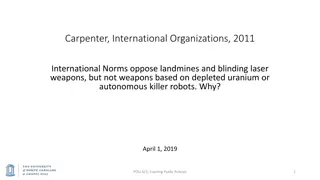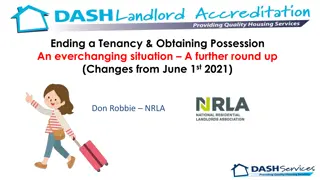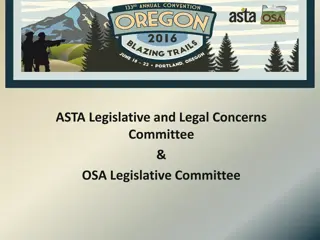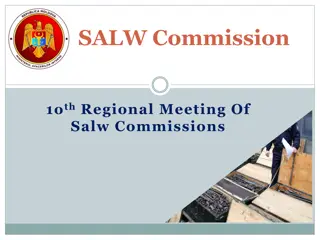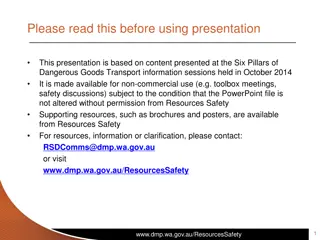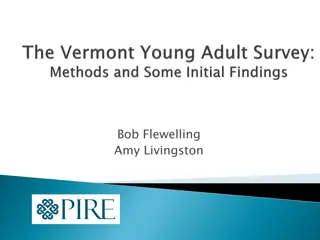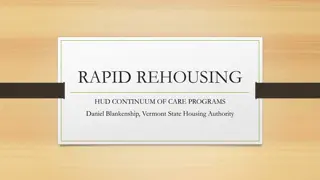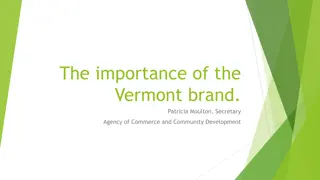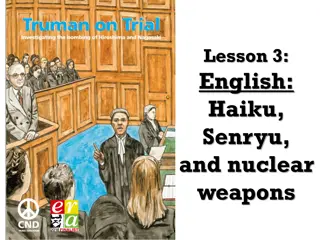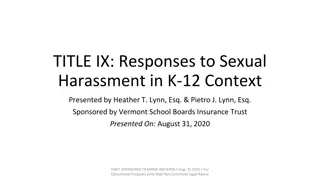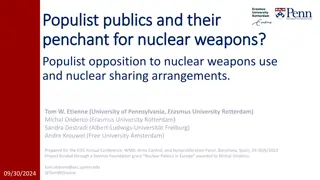Understanding Vermont's ACT 97: Prohibiting Possession of Dangerous Weapons
Vermont's ACT 97, effective as of 4-11-18, prohibits individuals from purchasing, possessing, or receiving dangerous weapons. This act allows for emergency orders to be issued for individuals posing a risk of harm and provides guidelines for law enforcement intervention in cases of extreme risk, such as threats of harm or suicidal ideation. Consultation with supervisors, adherence to agency protocols, and maintaining relationships with law enforcement and clients are crucial in addressing such situations.
Download Presentation

Please find below an Image/Link to download the presentation.
The content on the website is provided AS IS for your information and personal use only. It may not be sold, licensed, or shared on other websites without obtaining consent from the author. Download presentation by click this link. If you encounter any issues during the download, it is possible that the publisher has removed the file from their server.
E N D
Presentation Transcript
Kristin J. Chandler, J.D. Vermont Care Partners Webinar Summer, 2018
New Legislation Your experience Questions as we go
ACT 97 (S. 221) 4-11-18 effective date Prohibits a person from purchasing, possessing or receiving a dangerous weapon or having a dangerous weapon within their custody or control. An emergency order initially good for 2 weeks State s Attorney or AAG is involved
Dangerous weapon = an explosive or a firearm What s not a dangerous weapon ? Edged weapons - knives
The person poses an extreme risk of causing harm to himself/herself or another Shown by establishing that: Person has inflicted or attempted to inflict bodily harm on another or; His or her threats or actions has placed others in reasonable fear of physical harm or; By his or her actions or inactions, person has presented a danger to persons in their care.
An extreme risk of harm to self may be shown by establishing that the person has threatened or attempted suicide or serious bodily harm Where does this information come from?
Heres the tricky part Police write an affidavit to establish the need to emergently remove firearms from a person s home Police can get the information necessary from many sources family, the client, police records, crisis worker, case manager
Follow agency protocol/policies Consult with supervisor Importance of relationship with law enforcement Importance of relationship with your client Agency counsel?
Think about this: Current client, in the past, owned 3-4 firearms. You have knowledge of this. Currently, client has expressed thoughts of completing suicide. Do you contact law enforcement for purposes of removing the firearms?
Order prohibits person from purchasing, possessing or receiving, or having in their custody or control, a firearm - for up to 6 months. Control means constructive possession cannot be in a home with access to firearms.
Required to surrender all dangerous weapons in your custody, control, or possession to [law enforcement agency], a federally licensed firearms dealer, or a person approved by the court. Extreme Risk Protection Orders shall be served by the law enforcement agency and shall take precedence over other summonses and orders
LEO are authorized to enforce orders enforcement may include collecting and disposing of dangerous weapons and making an arrest. Non firearms go to ATF. Firearms taken by LEO shall be photographed, catalogued and stored If court ordered back to person, 3 days to do so.
Hearing is held within the 14 day emergency period to determine if the order should be in effect for 6 months. Right to appear. State s burden increases to clear and convincing evidence that the person continues to pose an extreme risk of causing harm to self or another if he/she possesses a dangerous weapon
1 year and/or $1,000.00 fine OR person gets prosecuted for criminal contempt State can seek to renew a final order
In Vermont, identifiable victim and threat is to person OR property Law Enforcement may be unfamiliar with your duty and how you may need to inform them Err on side of caution
The Kuligoski v. Brattleboro Retreat and Northeast Kingdom Human Services decision in 2016. Created increased duty/liability for MH professionals, stigmatized clients, potentially violated HIPAA and provided very little guidance.
1. The decision did not require the risk be serious or imminent. This put providers in a position of violating HIPAA. 2. Unlike the Peck duty, the Kuligoski decision did not require that the prospective victim be identifiable. 3. The Kuligoski decision singled out caregivers and potentially created a situation in which they could be held liable for the actions of the person for whom they were caring. 4. The Kuligoski decision imposes a duty on mental health facilities and professionals to protect the public from patients and clients who are no longer in their care or under their control.
Legislative Fix - ACT 51 - May 30, 2017 18 V.S.A. 1882 added This act negates the Vermont Supreme Court s decision in Kuligoski v. Brattleboro Retreat and Northeast Kingdom Human Services, and limits a mental health professional s duty to that as established in common law in Peck v. Counseling Service of Addison County, Inc.
a mental health professional who knows or, based upon the standards of the mental health profession, should know that his or her patient poses a serious risk of danger to an identifiable victim has a duty to exercise reasonable care to protect him or her from that danger.
During a client meeting, client threatens to take out as many kids as I can . You know he has access to a hunting rifle. You cannot move him off this statement. Do you have a duty to warn? During a client meeting, client is frustrated and angry with how the Shaw s clerk treated her the last time she was in the Berlin store. She says she d like to blow her and her house up! You cannot move her off this thought. Do you have a duty to warn?
Mental Health Warrant Application for Emergency Exam (EE) Criminal court ordered for purposes of a competency/sanity evaluation Revocation of an Order of Non- Hospitalization (ONH)
Statute changed in 2014 - where a person can be taken on a warrant (to any hospital) and some time frames Some law enforcement officers still have trouble understanding Warrant is used to get someone to a doctor it s a legal method of transporting them However, many people get transported to the ED under the temporary custody portion of the statute perfectly legal.
18 V.S.A. 7505(b) The law enforcement officer or mental health professional may take the person into temporary custody without delay for the warrant. temporary custody and shall apply to the court Where that temporary custody takes place depends on the officer and/or the law enforcement agency policy. Team Two training encourages ED, but depends on safety of all involved.
Mental Health warrant allows law enforcement to take patient from his/her home, to an ED for an emergency examination. A separate search warrant or arrest warrant is not necessary. If concerned, put that information should be in the warrant.
Initiated usually by QMHP (screener) 3 MH professionals must agree that person is a person in need of treatment -QMHP -physician -psychiatrist (within 24 hours of physician) Hold for 72 hours under an EE Reviewed by DMH Legal division Filed in family court Reviewed for probable cause by judge within 3 days
Criminal charges Competency or sanity is at issue Screener at court has determined person is a person in need of treatment If later determined to be incompetent, criminal charges often resolved with an ONH
ONH current, with conditions Client is not compliant with any one of the conditions DA notifies DMH Legal DMH Legal files a motion to revoke ONH Hearing is held to determine compliance Often takes so long, person has decompensated to the point where he/she has been EE d by the time of court date.
Whether its an ONH or an OH, ordered by family court or criminal court, involuntary commitment affects one s ability to possess a firearm. NICS reporting requirement Within 48 hours of being found to be a person in need of treatment or incompetent or insane Can petition to come off the registry
Summer study committee Various agencies around the table: MHLP, DMH, VCP, State s Attorney, DPS, VAHHS, NAMI, VPS, Judiciary, Defender General Report to the Legislature before next session Current system of ONH doesn t work very well
Other questions? Next Webinar: Nov 9, 12-1 Depression 101 for care coordinators -Julie Parker, NCSS




